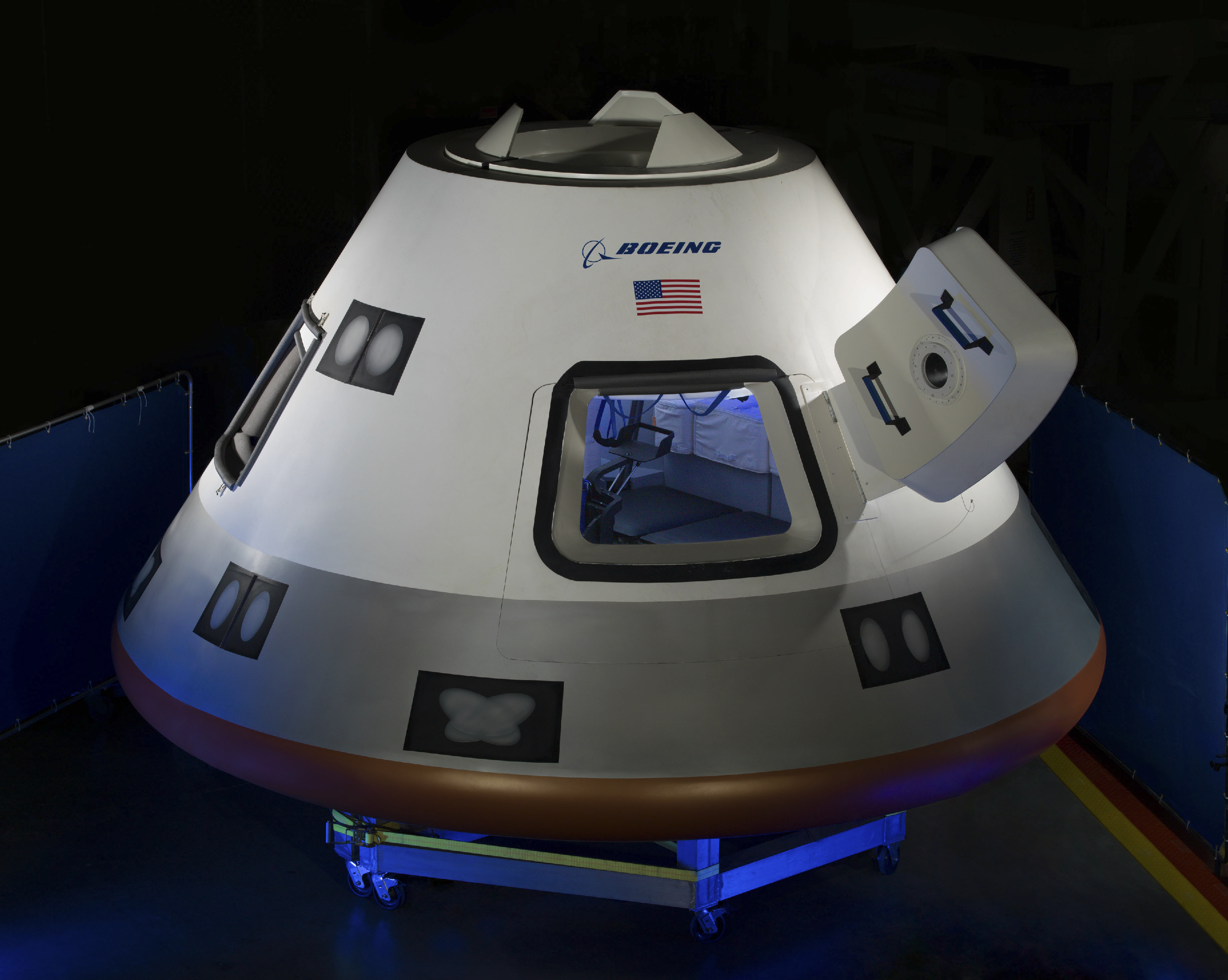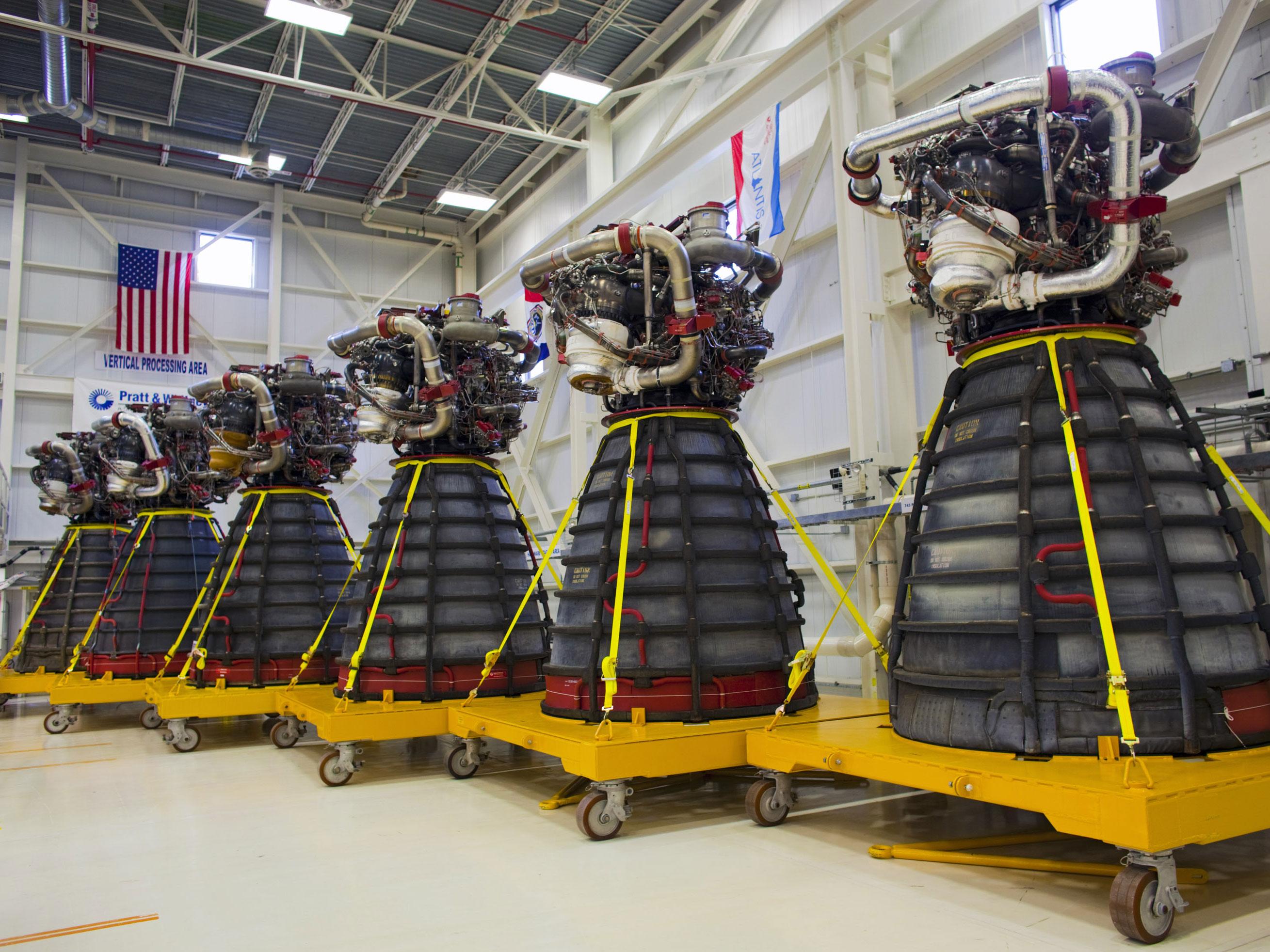|
Centaur Rocket Stage
The Centaur is a family of rocket propelled upper stages produced by U.S. launch service provider United Launch Alliance, with one main active version and one version under development. The diameter Common Centaur/Centaur III flies as the upper stage of the Atlas V launch vehicle, and the diameter Centaur V is being developed as the upper stage of ULA's new Vulcan rocket. Centaur was the first rocket stage to use liquid hydrogen (LH2) and liquid oxygen (LOX) propellants, a high-energy combination that is ideal for upper stages but has significant handling difficulties. Characteristics Common Centaur is built around stainless steel pressure stabilized balloon propellant tanks with thick walls. It can lift payloads of up to . The thin walls minimize the mass of the tanks, maximizing the stage's overall performance. A common bulkhead separates the LOX and LH2 tanks, further reducing the tank mass. It is made of two stainless steel skins separated by a fiberglass honeycomb. ... [...More Info...] [...Related Items...] OR: [Wikipedia] [Google] [Baidu] |
Atlas V
Atlas V is an expendable launch system and the fifth major version in the Atlas launch vehicle family. It was originally designed by Lockheed Martin, now being operated by United Launch Alliance (ULA), a joint venture between Lockheed Martin and Boeing. Atlas V is also a major NASA launch vehicle. It is America's longest-serving active rocket. In August 2021, ULA announced that Atlas V would be retired, and all 29 remaining launches had been sold. , 19 launches remain. Each Atlas V launch vehicle consists of two main stages. The first stage is powered by a Russian RD-180 engine manufactured by Energomash and burning kerosene and liquid oxygen. The Centaur upper stage is powered by one or two American RL10 engine(s) manufactured by Aerojet Rocketdyne and burns liquid hydrogen and liquid oxygen. The Star 48 upper stage was used on the '' New Horizons'' mission as a third stage. Strap-on solid rocket boosters (SRBs) are used in most configurations. AJ-60A SRBs were u ... [...More Info...] [...Related Items...] OR: [Wikipedia] [Google] [Baidu] |
Stainless Steel
Stainless steel is an alloy of iron that is resistant to rusting and corrosion. It contains at least 11% chromium and may contain elements such as carbon, other nonmetals and metals to obtain other desired properties. Stainless steel's resistance to corrosion results from the chromium, which forms a passive film that can protect the material and self-heal in the presence of oxygen. The alloy's properties, such as luster and resistance to corrosion, are useful in many applications. Stainless steel can be rolled into sheets, plates, bars, wire, and tubing. These can be used in cookware, cutlery, surgical instruments, major appliances, vehicles, construction material in large buildings, industrial equipment (e.g., in paper mills, chemical plants, water treatment), and storage tanks and tankers for chemicals and food products. The biological cleanability of stainless steel is superior to both aluminium and copper, having a biological cleanability comparable to glass ... [...More Info...] [...Related Items...] OR: [Wikipedia] [Google] [Baidu] |
CST-100 Starliner
The Boeing CST-100 Starliner is a class of two partially designed to transport crew to the (ISS) and other low-Earth-orbit destinations. It is manufactured by for its participation in 's |
Payload Fairing
A payload fairing is a nose cone used to protect a spacecraft payload against the impact of dynamic pressure and aerodynamic heating during launch through an atmosphere. An additional function on some flights is to maintain the cleanroom environment for precision instruments. Once outside the atmosphere the fairing is jettisoned, exposing the payload to outer space. The standard payload fairing is typically a cone-cylinder combination, due to aerodynamic considerations, although other specialized fairings are in use. The type of fairing which separates into two halves upon jettisoning is called a clamshell fairing by way of analogy to the bifurcating shell of a clam. In some cases the fairing may enclose both the payload and the upper stage of the rocket, such as on Atlas V and Proton M. If the payload is attached both to the booster's core structures and to the fairing, the payload may still be affected by the fairing's bending loads, as well as inertia loads due to vibra ... [...More Info...] [...Related Items...] OR: [Wikipedia] [Google] [Baidu] |
Delta Cryogenic Second Stage
The Delta Cryogenic Second Stage (DCSS) is a family of cryogenic rocket stages used on the Delta III and Delta IV rockets, and on the Space Launch System Block 1. The stage consists of a cylindrical liquid hydrogen (LH2) tank structurally separated from an oblate spheroid liquid oxygen (LOX) tank. The LH2 tank cylinder carries payload launch loads, while the LOX tank and engine are suspended below within the rocket's inter-stage. The stage is powered by a single Aerojet Rocketdyne- Pratt & Whitney RL10B-2 engine, which features an extendable carbon-carbon nozzle to improve specific impulse. Delta III The DCSS first flew on 3 Delta IIIs, failing two out of two times. A booster failed on the maiden flight and the rocket was destroyed by range safety, causing the loss of the DCSS before ignition. On its second flight, the stage tumbled uncontrollably, inserting the payload into a useless orbit. On the third flight, the stage performed the planned burn but fell short of the ta ... [...More Info...] [...Related Items...] OR: [Wikipedia] [Google] [Baidu] |
Specific Impulse
Specific impulse (usually abbreviated ) is a measure of how efficiently a reaction mass engine (a rocket using propellant or a jet engine using fuel) creates thrust. For engines whose reaction mass is only the fuel they carry, specific impulse is exactly proportional to the effective exhaust gas velocity. A propulsion system with a higher specific impulse uses the mass of the propellant more efficiently. In the case of a rocket, this means less propellant needed for a given delta-v, so that the vehicle attached to the engine can more efficiently gain altitude and velocity. In an atmospheric context, specific impulse can include the contribution to impulse provided by the mass of external air that is accelerated by the engine in some way, such as by an internal turbofan or heating by fuel combustion participation then thrust expansion or by external propeller. Jet engines breathe external air for both combustion and by-pass, and therefore have a much higher specific impulse than ... [...More Info...] [...Related Items...] OR: [Wikipedia] [Google] [Baidu] |
Helium
Helium (from el, ἥλιος, helios, lit=sun) is a chemical element with the symbol He and atomic number 2. It is a colorless, odorless, tasteless, non-toxic, inert, monatomic gas and the first in the noble gas group in the periodic table. Its boiling and melting point are the lowest among all the elements. It is the second lightest and second most abundant element in the observable universe (hydrogen is the lightest and most abundant). It is present at about 24% of the total elemental mass, which is more than 12 times the mass of all the heavier elements combined. Its abundance is similar to this in both the Sun and in Jupiter, due to the very high nuclear binding energy (per nucleon) of helium-4, with respect to the next three elements after helium. This helium-4 binding energy also accounts for why it is a product of both nuclear fusion and radioactive decay. The most common isotope of helium in the universe is helium-4, the vast majority of which was formed during t ... [...More Info...] [...Related Items...] OR: [Wikipedia] [Google] [Baidu] |
Monopropellant Rocket
A monopropellant rocket (or "monochemical rocket") is a rocket that uses a single chemical as its propellant. Chemical-reaction monopropellant rockets For monopropellant rockets that depend on a chemical reaction, the power for the propulsive reaction and resultant thrust is provided by the chemical itself. That is, the energy needed to propel the spacecraft is contained within the chemical bonds of the chemical molecules involved in the reaction. The most commonly used monopropellant is hydrazine (N2H4), a chemical which is a strong reducing agent. The most common catalyst is granular alumina (aluminum oxide) coated with iridium. These coated granules are usually under the commercial labels Aerojet S-405 (previously made by Shell) or W.C.Heraeus H-KC 12 GA (previously made by Kali Chemie). There is no igniter with hydrazine. Aerojet S-405 is a spontaneous catalyst, that is, hydrazine decomposes on contact with the catalyst. The decomposition is highly exothermic and produces ... [...More Info...] [...Related Items...] OR: [Wikipedia] [Google] [Baidu] |
Hydrazine
Hydrazine is an inorganic compound with the chemical formula . It is a simple pnictogen hydride, and is a colourless flammable liquid with an ammonia-like odour. Hydrazine is highly toxic unless handled in solution as, for example, hydrazine hydrate (). Hydrazine is mainly used as a foaming agent in preparing polymer foams, but applications also include its uses as a precursor to polymerization catalysts, pharmaceuticals, and agrochemicals, as well as a long-term storable propellant for in-space spacecraft propulsion. Additionally, hydrazine is used in various rocket fuels and to prepare the gas precursors used in air bags. Hydrazine is used within both nuclear and conventional electrical power plant steam cycles as an oxygen scavenger to control concentrations of dissolved oxygen in an effort to reduce corrosion. the world hydrazine hydrate market amounted to $350 million. About two million tons of hydrazine hydrate were used in foam blowing agents in 2015. Hydra ... [...More Info...] [...Related Items...] OR: [Wikipedia] [Google] [Baidu] |
Ullage
Ullage or headspace is the unfilled space in a container, particularly with a liquid. Etymology The word ''ullage'' comes from the Latin word ''oculus'', used by the Romans to refer to a barrel cork hole. This word was, in turn, taken in medieval French as ''oeil'', from which a verb ''ouiller'' was created, meaning to fill a barrel to full capacity. Around 1300, the word ''ouillage'' was created by the Normans to refer to the amount of liquid needed to fill a barrel to capacity. Alcoholic beverages In winemaking, ''ullage'' came to refer to any amount by which a barrel is unfilled, perhaps because some of the contents have been used. It is also applied to the unfilled air space at the top of a bottle of wine, which in this case is essential to allow for expansion of the contents as the temperature changes. By further extension, in brewing and beer retail, ''ullage'' is the residue of beer left in a barrel that has been emptied. When calculating tax returns and the like, license ... [...More Info...] [...Related Items...] OR: [Wikipedia] [Google] [Baidu] |
Reaction Control System
A reaction control system (RCS) is a spacecraft system that uses thrusters to provide attitude control and translation. Alternatively, reaction wheels are used for attitude control. Use of diverted engine thrust to provide stable attitude control of a short-or-vertical takeoff and landing aircraft below conventional winged flight speeds, such as with the Harrier "jump jet", may also be referred to as a reaction control system. Reaction control systems are capable of providing small amounts of thrust in any desired direction or combination of directions. An RCS is also capable of providing torque to allow control of rotation ( roll, pitch, and yaw). Reaction control systems often use combinations of large and small ( vernier) thrusters, to allow different levels of response. Uses Spacecraft reaction control systems are used for: * attitude control during different stages of a mission; * station keeping in orbit; * close maneuvering during docking procedures; * con ... [...More Info...] [...Related Items...] OR: [Wikipedia] [Google] [Baidu] |
Aerojet Rocketdyne
Aerojet Rocketdyne is an American manufacturer of rocket, hypersonic, and electric propulsive systems for space, defense, civil and commercial applications. Headquartered in Sacramento, California, the company is owned by Aerojet Rocketdyne Holdings. Aerojet Rocketdyne was formed in 2013 when Aerojet (then owned by GenCorp) and Pratt & Whitney Rocketdyne were merged, following the latter's acquisition by GenCorp from Pratt & Whitney. On April 27, 2015, the name of the holding company, GenCorp, was changed from ''GenCorp, Inc.'' to ''Aerojet Rocketdyne Holdings, Inc''. Lockheed Martin announced plans to take over Aerojet Rocketdyne on December 20, 2020 as part of a $4.4 billion acquisition; however this was abandoned by Lockheed on February 13, 2022 after opposition from Raytheon led the FTC to move to block the acquisition. Products Current engines * RS-25 ( LH2/ LOX) – Previously known as the Space Shuttle main engine (SSME), it was the reusable main engine developed by ... [...More Info...] [...Related Items...] OR: [Wikipedia] [Google] [Baidu] |










